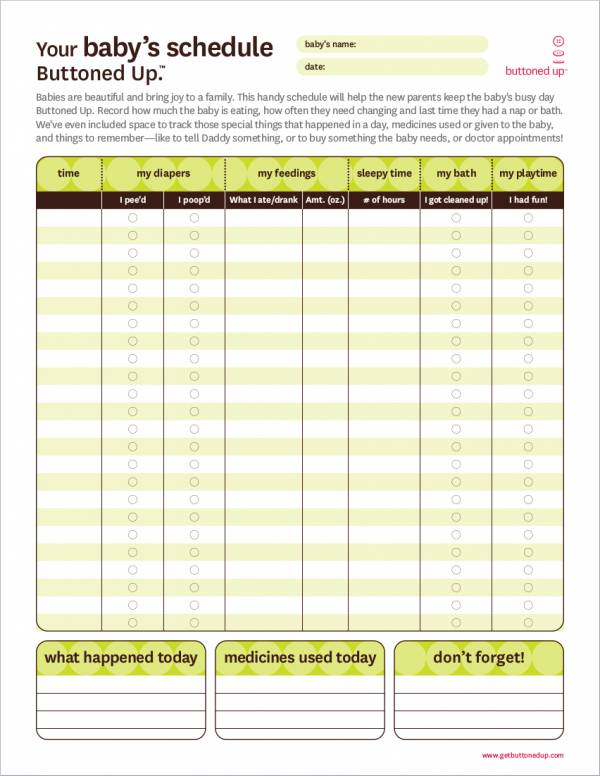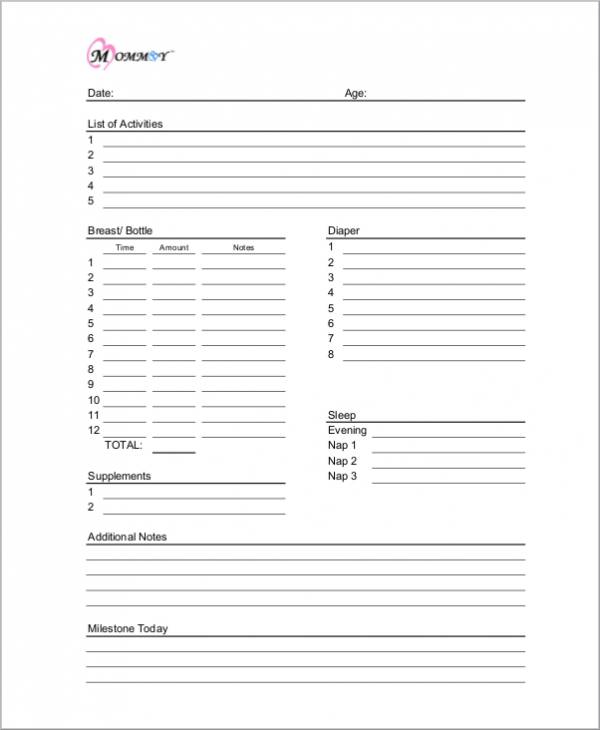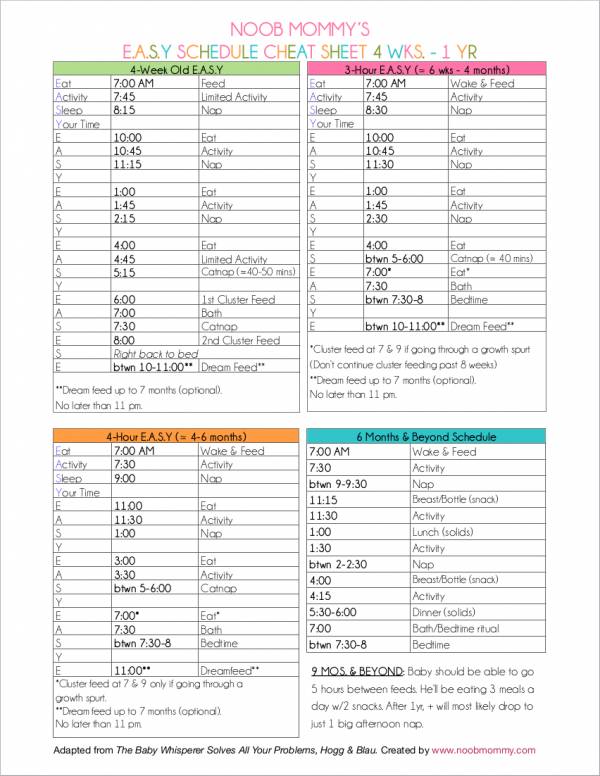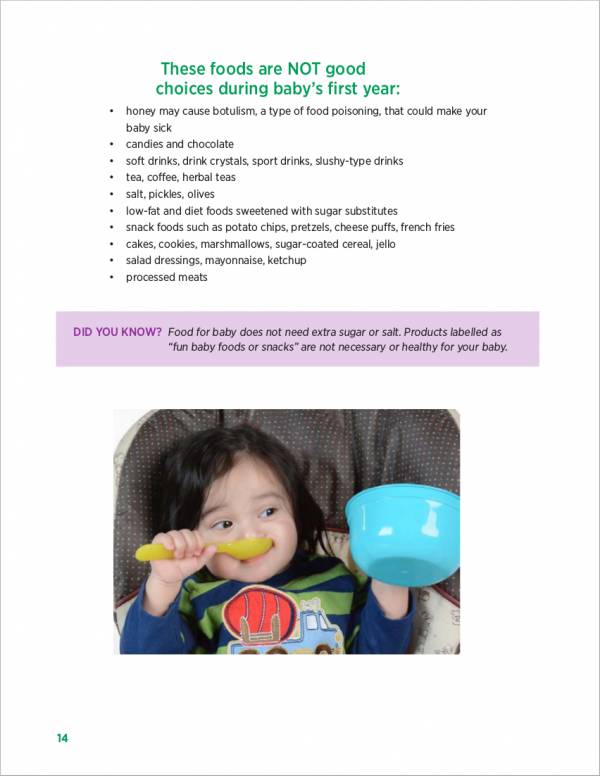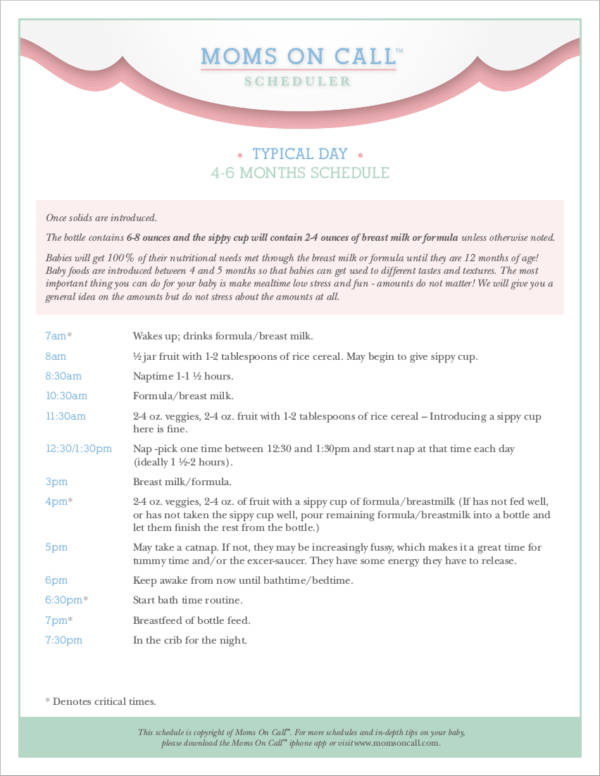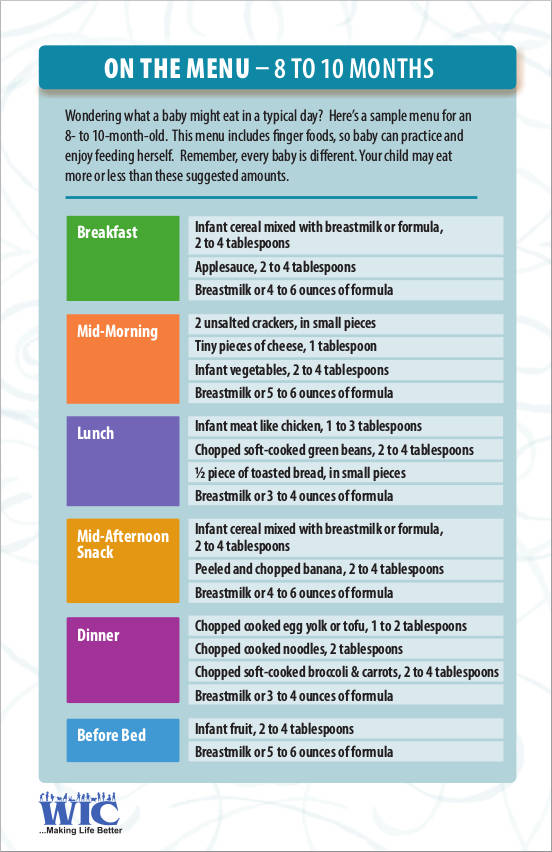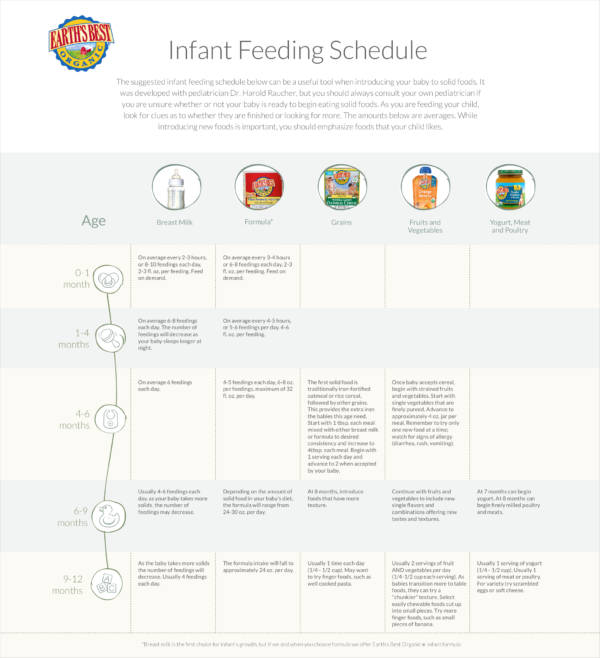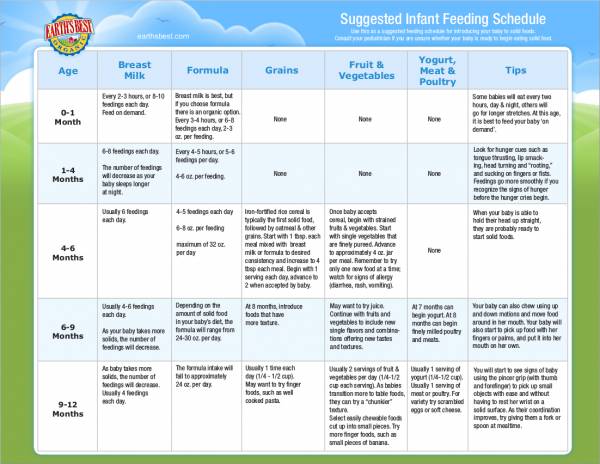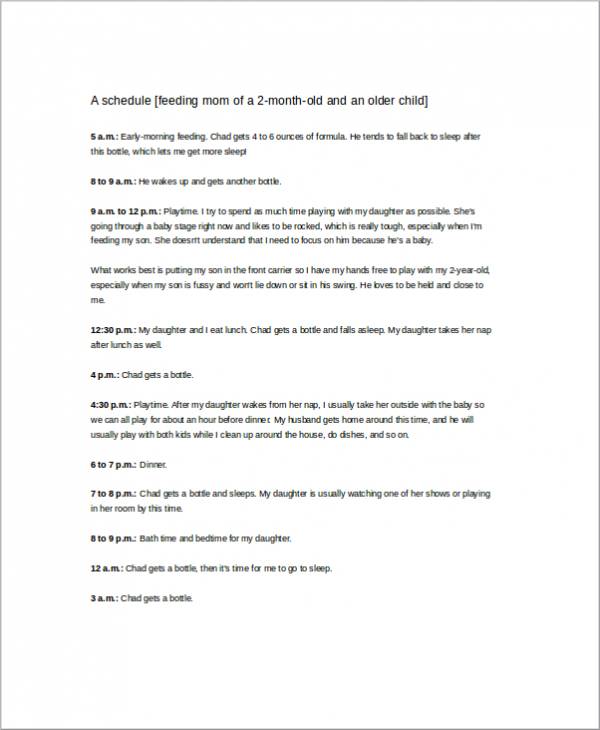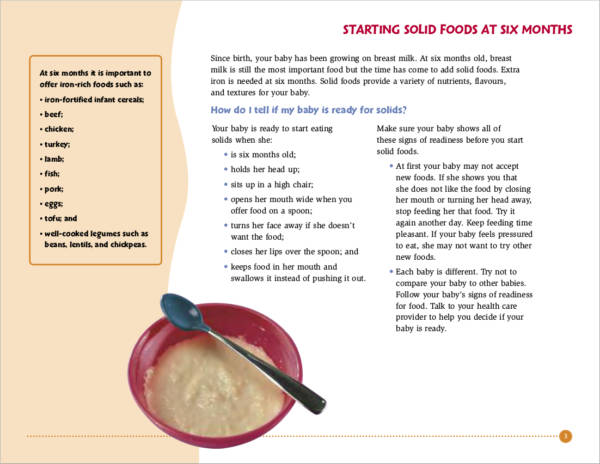Babies and little children don’t know how to feed themselves. They need their parents to feed them and take care of them to make sure that they don’t get hungry. Babies can’t talk yet and some children still can’t say things clearly. When they are hungry they cry, but they also cry when they are sleepy, when they need to go potty, and if they feel pain. This makes it hard for parents to tell if their babies or children are hungry or not. Perhaps using a time schedule will help.
- Sample Schedules
- Schedule Samples in Word
The best way to help parents with feeding their babies and providing the care that they need is through the use of a baby feeding schedule. Years of research has found a way to help parents feed their babies at the right time and at the right age. The baby feeding schedule sample not only provides information on how babies should be fed, but it also provides details on what must not be given to them and other activities that help in taking care of them.
Printable Baby Schedule Form
Blank Baby Feeding Schedule
Easy Baby Feeding Schedule Sheet
Effective Baby Feeding Schedule
Baby Feeding Schedule with Meals
Why Do You Need to Use a Baby Feeding Schedule?
Mothers need to know when their babies are hungry to be able to feed them, especially with breastfed babies. Parents don’t really have to wait for babies to cry or act up to feed them. All they need is a baby feeding schedule to make sure that they feed their babies on time and give them the care that they need. Below are the reasons why parents need to use it. You can also like baby chart template.
- There are parents who don’t know when to feed their babies and this is fine, especially those who just became parents. Using a baby feeding schedule will help them create a feeding routine so that they can give their baby all the nutrition the baby needs to grow and become healthy. Utilizing a baby feeding chart can help with this as well.
- There are times when you have to leave your baby or child with a relative or a babysitter for a day or two. Even if you leave them with instructions on your baby’s feeding schedule example, they might not exactly remember it and miss out on some important details. You can use a baby feeding schedule that you made yourself and hand it to them so that they won’t have to memorize what you tell them. You can rest assured that your baby is not starved and gets the proper nutrition for proper growth. You can use a baby growth chart to track your baby’s physical development.
- Babies cry when they need something, but it doesn’t always mean that they are hungry. Some babies, on the other hand, just tend to sleep a lot even when it’s their feeding time. Babies can’t say anything and some won’t even cry to tell their parents that they are hungry. This is a problem that a lot of parents face. This is where they will need to use a baby feeding schedule. You can also see baby registry checklists.
- A baby feeding schedule helps you decide when to feed your baby with solid food. It helps you determine when your baby is ready for it. It also includes a list of food that you should give them first, what food you should not give them, and what food to avoid to prevent having allergic reactions at a very young age.
- A baby feeding schedule not only includes the time when babies should be fed, it also includes what food should be served to your baby.
When Should You Feed Your Baby?
If you would be asked this question, you would immediately say that you feed your baby when they are hungry or asking for food. This is actually right, but not quite. As we have mentioned above, not all babies cry when they are hungry. Without this cue, how would you now that it is time to feed your baby? Using a baby feeding schedule will help you know when you should feed your baby. You can also like baby shower invitations.
The age of your baby will help determine how frequently you should feed them. Newborn babies need to be fed every two hours. Yes, that’s a lot of feeding to do. For weaning babies, they need to be fed 5 to 6 small meals a day. It should be small meals because they don’t have the same appetite as adults. Check out some baby milestones charts to know when your baby should be be able to do things as he/she grows.
There are also other signs aside from crying that will help you determine that your baby is ready to eat or is hungry. They are listed below:
- Baby smacks lips or opens mouth, especially when stimulated.
- Baby opens mouth when they are offered food or milk in bottle.
- Baby reaches for food that is near them.
Pediatricians always advise parents and mothers to only introduce solid food to babies when they are ready and that is at 6 months of age. Teething is not necessarily a sign that you should feed your baby with solid foods. Introducing solid foods too early may cause some disruption in the baby’s diet and they may not breastfeed that much. Remember that breast milk is best for babies up to 2 years. To monitor the progress of the growth of your child, a baby development chart will come in handy.
4-6 Months Baby Feeding Schedule
Typical Baby Feeding Schedule Sample
36 Months Baby Feeding & Needs Schedule
Infant Feeding Schedule Sample
Suggested Infant Feeding Schedule
2-Month-Old Baby Feeding Schedule
One Week Baby Feeding Schedule
Baby Feeding Schedule for Six Months
Why Should You Wait Until Your Baby Is 6 Months Old to Start Solid Foods?
Introducing solid foods to your baby before they are 6 months old have disadvantages and they are as follows:
- It will cause babies to drink less breast milk or formula milk. Breast milk and formula milk contains all the needed nutrients that babies need as they grow. If they drink less milk, then they will get lesser nutrients and this will, later on, become a problem with their nutrition. To determine what is right when the baby is growing, you can check out baby charts as reference.
- Babies may not yet be ready for solid food. They may have problems swallowing solid foods and choke.
On the other hand, there is also a disadvantage if you wait too long to feed your baby with solid foods. Your baby might have eating problems and they might not get the idea as to why they are being fed with solid food instead of milk. Some babies end up getting a speech or occupational therapist to help them learn how to eat solid food.
When Do You Know That Your Baby Is Ready for Solid Foods?
You don’t have to be a pediatrician or an expert mom to be able to tell when your baby is ready for solid foods. You don’t even have to guess. You only need to know the signs that your baby is ready for solid food. You can also like babysitter resumes.
- Your baby is ready for solid food if they are able to sit up with very little support from you.
- Your baby is ready for solid food if they open their mouth when they are offered food.
- Your baby is ready for solid food when they are able to hold their head up.
- Your baby is ready for solid food if they turn their heads away when they don’t want to eat anymore of if they refuse the food being offered to them.
Uses of a Baby Feeding Schedule
Below are the uses of a baby feeding schedule that you should know.
- A baby feeding schedule is used as a guide to help parents determine when they should feed their babies. It provides the intervals and frequency on when to feed their babies based on their age and level of preparedness. You can use an hourly schedule template to monitor and note those feedings.
- A baby feeding schedule not only provides you with your baby’s feeding schedule, it also includes helpful information and useful instructions on how to give your baby the nutrients that they need.
- A baby feeding schedule includes the list of food that are allowed during weaning and what food must not be given to babies at a certain age.
- A baby feeding schedule keeps track of your baby’s feeding activity to ensure that they are not overfed or undernourished.
Feeding your baby on schedule and giving them the right food that they need for proper nutrition is important. It is always a good practice to follow your schedule. If you are having problems keeping up with yours, you might want to take a look at other schedule samples that we offer on our website. Some sample schedules are immunization schedule samples, amortization schedule samples, and meeting schedule samples.
Related Posts
FREE 10+ Gym Schedule Samples in PDF | MS Word | Apple Pages | Google Docs | Keynote |
FREE 10+ Daily Hourly Schedule Samples in PDF
FREE 10+ Weekly Schedule Template with Hours Samples in PDF
FREE 10+ 7 Day Weekly Schedule Samples in PDF
FREE 10+ Working Schedule Template Samples in PDF
FREE 6+ Preschool Schedule Template Samples in PDF
FREE 10+ Daily School Schedule Samples in PDF | MS Word | Google Docs | Google Sheets | Excel
FREE 10+ Day Schedule Samples in PDF
FREE 10+ Daily Work Schedule Samples in PDF
FREE 10+ 24 Hours Schedule Samples in PDF | Word | Google Docs | Google Sheets | Excel | Apple Numbers | Apple Pages
FREE 10+ Baseball Schedule Samples in PDF
FREE 10+ Availability Schedule Samples in PDF
FREE 10+ Weekly Cleaning Schedule Samples in PDF
FREE 8+ Employee Scheduler Template Samples in PDF
FREE 10+ Weekly Work Schedule Samples in PDF

